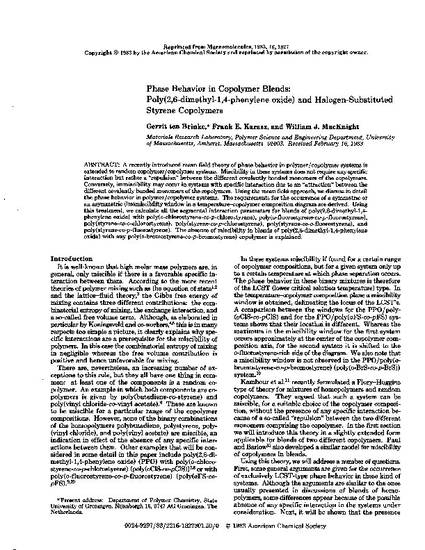
Article
Phase Behavior in Copolymer Blends: Poly(2,6-dimethyl-1,4-phenylene oxide) and Halogen-Substituted Styrene Copolymers
Macromolecules
(1983)
Abstract
A recently introduced mean field theory of phase behavior in polymer/ copolymer systems is extended to random copolymer/ copolymer systems. Miscibility in these systems does not require any specific interaction but rather a "repulsion" between the different covalently bonded monomers of the copolymers. Conversely, immiscibility may occur in systems with specific interaction due to an "attraction" between the
different covalently bonded monomers of the copolymers. Using the mean field approach, we discuss in detail the phase behavior in polymer/ copolymer systems. The requirements for the occurrence of a symmetric or an asymmetric (im)miscibility window in a temperature-copolymer composition diagram are derived. Using this treatment, we calculate all the segmental interaction parameters for blends of poly(2,6-dimethyl-1,4-phenylene oxide) with poly(o-chlorostyrene-co-p-chlorostyrene), poly(o-fluorostyrene-co-p-fluorostyrene), poly(styrene-co-o-chlorostyrene), poly(styrene-co-p-chlorostyrene), poly(styrene-co-o-fluorostyrene), and poly(styrene-co-p-fluorostyrene). The absence of miscibility in blends of poly(2,6-dimethyl-1,4-phenylene
oxide) with any poly(o-bromostyrene-co-p-bromostyrene) copolymer is explained.
Keywords
- Phase Behavior,
- Copolymer Blends,
- Poly(2 6-dimethyl-1 4-phenylene oxide),
- Halogen-Substituted,
- Styrene Copolymers
Disciplines
Publication Date
1983
Citation Information
William MacKnight, Gerrit ten Brinke and F. E. Karasz. "Phase Behavior in Copolymer Blends: Poly(2,6-dimethyl-1,4-phenylene oxide) and Halogen-Substituted Styrene Copolymers" Macromolecules Vol. 16 (1983) p. 1827 - 1832 Available at: http://works.bepress.com/william_macknight/107/
